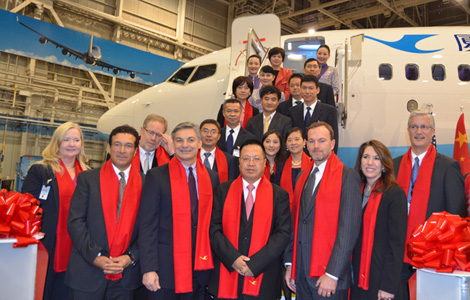Robots help counter soaring labor costs
Updated: 2013-11-14 00:43
By WEI TIAN in Shanghai (China Daily)
|
||||||||
Zhejiang province is to invest 500 billion yuan ($82 billion) over the next five years to encourage manufacturers to adopt more robots to overcome the short supply and high cost of labor.
The program is underway and will help at least 5,000 companies a year, a source with the investment division of the Zhejiang Economic and Information Commission told China Daily, without giving details.
Replacing humans with robots is the most effective way to tackle the labor shortage and rising labor costs, the commission said.
From 2005 to 2012, average labor costs in Zhejiang, a hub for private manufacturing enterprises, almost tripled from 14,847 yuan to 41,370 yuan a year, with an annual increase of nearly 16 percent.
In a survey conducted by the commission in May, 75 percent of respondents said rising costs were the main reason for switching to robots.
As factories used more robots, the proportion of surveyed enterprises with labor shortages dropped from 80 percent last year to 56.4 percent. The survey was based on replies from 515 enterprises that have introduced robot workers.
More than 60 percent of the enterprises surveyed have reduced production line employees by at least 10 percent, while 16 percent of the firms have cut their production jobs by more than 30 percent. Meanwhile, robot workers have helped these factories improve productivity by more than 10 percent.
If such a strategy is adopted by large enterprises throughout the province, the labor shortage will be reduced by 700,000 workers, saving 29 billion yuan in labor costs a year, the commission said.
Li Gang, president of the robotics sector in China at ABB, a leading supplier of industrial robots, said China has become a "world factory", but with increasing awareness of health and safety the manufacturing sector faces challenges in the workplace.
"Replacing workers with robots in dangerous and unhealthy working environments and using them for more creative jobs will be an inevitable choice for China's manufacturing sector," Li said.
He was speaking at a forum during the 15th China International Industry Fair in Shanghai last week.
Li said robot sales in China accounted for 21 percent of the world's total in 2012, and he estimates that the country will become the largest robot market in the next year or two.
Experts ruled out the possibility of robots triggering job losses.
Feng Xiliang, deputy dean of the school of labor economics at Capital University of Economics and Business in Beijing, said using more robots is a rational choice made by companies to tackle the labor shortage.
"But there are jobs that cannot be managed by robots at the moment," Feng said, adding that fewer jobs for humans in the industrial sector could release extra labor for the booming service sector, which has a much greater capacity for employment.
However, using robots still doesn't appear to be a cost-effective choice for some enterprises, with the high initial investment remaining a main concern for business owners in Zhejiang, especially for cash-strapped smaller companies.
The commission's survey found that only 17 percent of enterprises are willing to pay more than 10 million yuan to implement the robot substitution strategy, with most expecting to recover the investment within two to three years.
More than 80 percent believe government subsidies should be granted for robot purchases, while more than half the respondents said they will only consider buying robots if such an incentive is introduced.
Most said robots are the choice for large companies and that using human labor is still generally cheaper than buying robots.
"Demand for robots will be strong in China," said Wang Tianmiao, head of the expert panel on robot technology under the State High-Tech Development Plan. "We've only seen the tip of the iceberg. Use of robots will penetrate many sectors, such as telecommunications and healthcare."
With a flourishing robot market, Wang said, prices will be more transparent and acceptable for buyers as domestic robot companies emerge.
Ma Longguan, president of Shenyin and Wanguo Securities, said the number of robots shared per 10,000 workers averages 55 globally, nearly 350 in South Korea and Japan, but in China it is only 21.
"South Korea's industrial robot market developed quickly when the country's per capita GDP hit $6,000," Ma said. "China's per capita GDP is now $6,700, so we are just at the start of a market boom."

 China's changing fashion since 1978
China's changing fashion since 1978
 Top 10 romantic places to meet your Miss Right
Top 10 romantic places to meet your Miss Right
 Rare bird finds sanctuary
Rare bird finds sanctuary
 Government leaders to be held accountable for school safety
Government leaders to be held accountable for school safety
 Deadly looting in Philippines
Deadly looting in Philippines
 Graduation celebration for Santas
Graduation celebration for Santas
 One World Trade Center deemed tallest US skyscraper
One World Trade Center deemed tallest US skyscraper
 Xiamen Airlines gets milestone 100th Boeing
Xiamen Airlines gets milestone 100th Boeing
Most Viewed
Editor's Picks

|

|

|

|

|

|
Today's Top News
SAT alternative makes bid for Chinese takers
GM international office moves to Singapore
Leader honored for improving cross-Strait ties
Government leaders accountable for school safety
Banks'nonperforming loans up slightly in Q3
Investment treaty with US offers risks and rewards
Quality growth 'to be achieved'
PLA aims for global connections
US Weekly

|

|





